 |
In reading much more than I intended about the adventures of Clyde Barrow and Bonnie Parker, I came away thinking they were, overall, the two least interesting people involved in those adventures.
The photo above — the nicest one I've ever seen of Ms. Parker — is a nice tribute to the couple who seemed almost determined to die the way they did on May 23, 1934 — gunned down while they sat in a car they had stolen. But these two don't deserve a nice tribute. They pretty much deserved what some Texas Rangers and Louisiana policemen did to them.
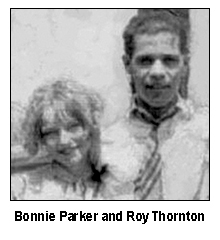 Another photo, taken with her husband, Roy Thornton (left), makes her look almost sweet. They were married just before her 16th birthday, and a few years before she voluntarily threw away her future. Another photo, taken with her husband, Roy Thornton (left), makes her look almost sweet. They were married just before her 16th birthday, and a few years before she voluntarily threw away her future.
She hardened considerably after that. Still, it struck me as odd that I didn't found any description of Bonnie Parker as "attractive." Newspapers of that era were notorious for calling women "pretty," "lovely," or "alluring," even when photos indicated the truth was quite the opposite.
BONNIE PARKER? "She's not much to look at," said a policeman after he'd been forced to spend several hours with her and Clyde, who had abducted the lawman. Apparently, the policeman wasn't saying this out of bitterness, because he said Barrow was a good-looking guy, but that both he and his girl friend cussed a lot, and that she smoked all of his cigarettes.
While she and Barrow were zigzagging all over the place, she suffered burns that disfigured her left leg. That happened when Barrow missed a warning sign and drove off the road, sending his car down an embankment. The burns were caused by dripping battery acid.
She also suffered minor wounds and injuries. Because she and Barrow avoided hotels and slept in a car or in a field, both of them began to look like things a cat might drag in. Baths were few and far between. She and Clyde smelled as though they had been sprayed by a skunk.
Their attitude about life on the run conflicted with that of Raymond Hamilton, a pint-sized robber who ran with Barrow in 1932 and rejoined him for a short stint in 1934. Hamilton is acknowledged as a better bank robber than Barrow, which may be one reason he preferred to use some of the loot to stay in hotels.
HAMILTON'S longtime girl friend, Mary O'Dare, was a source of irritation to Bonnie and Clyde, particularly Clyde. O'Dare was particularly critical of Barrow's insistence on roughing it. She also demanded the same share from a bank robbery as Barrow gave Bonnie.
Most folks who write about Bonnie and Clyde badmouth Mary O'Dare, but she lived a much more interesting life than either of them — and lived a lot longer, passing away in 2010, just shy of her 95th birthday.
Hamilton also was an interesting guy, escaping prison twice, the second time while he was on death row, eventually dumping Mary O'Dare and replacing her with Katie Jenkins*, a nightclub entertainer, who had a lovely face, but incredibly bad taste in men. She visited him for the last time the day before he was electrocuted in Huntsville (Texas) prison in 1935.
Raymond Hamilton's brother, Floyd, figures in the story of Bonnie and Clyde. Floyd Hamilton helped set up a prison break that was engineered from the outside by Clyde Barrow.
There's disagreement over the reason Barrow helped four inmates escape from Eastham Prison Farm on January 16, 1934. Several folks say it was to liberate Floyd's brother. Indeed, when he was put in Eastham, Ray Hamilton said Clyde Barrow would get him out.
|
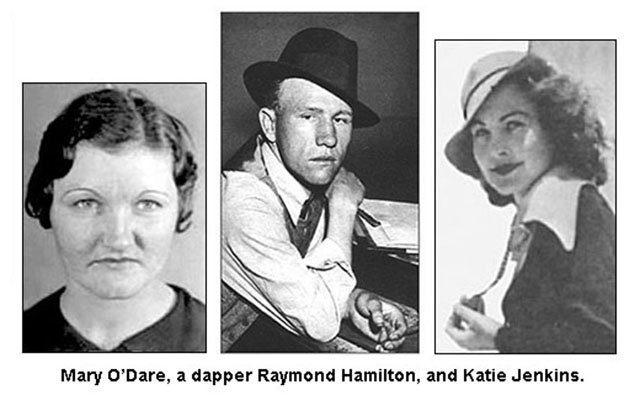 |
BUT THERE'S a more convincing argument that Barrow originally planned the breakout — referred to in many newspapers of the era as "a delivery" — in order to spring a good friend, Ralph Fults, but Fults was moved and no longer part of the work detail that went out into the fields.
Fults got word to Barrow to spring Hilton Bybee instead, while Barrow himself set out to free Joe Palmer and Henry Methvin, which would prove perhaps the biggest mistake Barrow ever made. With Floyd Hamilton assisting on the outside, and his brother the type who could cause trouble inside, Raymond Hamilton made it a party of four when Barrow and another ex-convict, Jimmy Mullens, showed up with guns on the day of the breakout, with Bonnie Parker remaining in the car. Another convict, J. B. French, took advantage of the situation, but was denied a place in the getaway car and soon was recaptured.
Anyway, Floyd Hamilton eventually becomes a notorious outlaw himself. As one of the Bonnie and Clyde online experts pointed out, Mrs. Hamilton, the mother, must have been so proud — having two sons who made it to the top of the Texas most-wanted list.
However, Floyd Hamilton is perhaps the most interesting story, because he lived to find God. His prison ministry eventually won him pardons from President Johnson and former Texas Gov. John Connally.
BACK TO Bonnie Parker. Besides her false reputation as a cigar smoker, she also was portrayed as a trigger-happy gunwoman whose accuracy with a machine gun matched Clyde Barrow's. Newspaper stories said she stood at his side during shootouts with lawmen.
This was nonsense, of course, but the stories never varied. W. D. Jones, who would claim he was abducted into the Barrow gang, once said he had never seen Bonnie Parker fire a gun. At other times he told other stories, saying she occasionally fired shots from the car, usually during escapes.
Jones temporarily escaped the gang on April 27, after he sent to steal a car in Ruston, Louisiana. Barrow and Parker would return to Texas about five weeks later and force Jones to re-join the outfit. Which means Jones was not with them — and Buck Barrow and Blanche — on May 12 when this happened:
|
Syracuse Journal, May 12, 1933
LUCERNE, Indiana (INS) — Two women bank robbers, one of them a blonde armed with an automatic rifle, sprayed a crowd with bullets during a spectacular, but unsuccessful attempt by a bandit gang to hold up the Lucerne State Bank here today.
Bullets fired by the young bandit queen wounded slightly Miss Ethel Witters and Mrs. Doris Minor.
The gang, consisting of two women and two men, all between the ages of 20 and 25 years, and all heavily armed, escaped in a sedan without loot.
Miss Witters, 20, was shot down in front of the bank when the feminine bandit turned a machine gun loose on a crowd that gathered following the first exchange of shots, and Mrs. Minor, 24, was hit while dressing in her bedroom at her home near the bank.
The wildest excitement prevailed in the town as the machine gun splattered a leaden hail along the street.
The bandits escaped in a cloud of gunsmoke west along state road 16.
Everett Gregg, 48, cashier, and Lawson Zelders, 24, bookkeeper, were alone in the bank shortly after it opened.
Gregg was turning to enter the vault when suddenly a gun was poked in his face from a storage space above the vault. He looked up, astonished, and saw a rough, bearded face. The man was lying on top of the vault.
The cashier dived into the vault in spite of the bandit’s command to stick up his hands.
Immediately the gunman jumped down, followed by another desperado. Both starting firing point blank into the vault.
The two gunmen then rushed out of the back door of the bank. They were seen getting into a small sedan containing two women.
The bandit car disappeared, but showed up within a block of the bank. By that time a crowd of 15 or 20 persons had gathered in front of the bank.
Ruthlessly, one of the women bank robbers pushed an automatic rifle out of the window of the outlaw machine and raked the crowd with a stream of lead. |
|
According to a 2014 story by Al Hunter on weeklyview.net, an Indianapolis newspaper website, the botched Lucerne bank job was the work of the Barrow gang.
This belief apparently is largely based on Blanche Barrow's memoirs. She said Clyde and Buck broke into the bank the night before and waited to confront the clerks in the fashion described above. Considering the way the Barrows lived, it's not surprising that one or both men — temporarily, at least — had rough, bearded faces.
During their escape, after their robbery was foiled, a man hopped on the hood of the getaway car, and Clyde yelled for someone to shoot the man. It was Bonnie who fired the automatic rifle. Granted, it's impossible to be accurate while firing from a moving vehicle, but she hit two people she had no intention of hurting, including one woman inside a nearby building. According to Blanche's story, Bonnie also killed a couple of pigs being herded across the road.
As for standing side by side with Clyde during shootouts, forget about it. Their most famous battle might well have been the one a month before the Lucerne, Indiana, incident, when Clyde and Buck did the shooting as the women and W. D. Jones, still with the gang at that point, scrambled into one of the cars they had obtained and kept at their Joplin, Missouri, hideout. It was on this occasion Bonnie and Clyde left behind a lot of weapons, clothes and an interesting roll of undeveloped film.
Also left behind was something else that contributed to the slow-growing legend of two inept robbers — an unfinished poem called "The Story of Suicide Sal," which Bonnie Parker had written, supposedly about a woman she had met in jail. (Bonnie Parker was arrested after another botched robbery attempt, in 1932, and was held in jail for six weeks until the case against her collapsed.)
After the Joplin incident, Bonnie Parker often was called "Suicide Sal," though the poem was probably about someone else. Here are a couple of stanzas:
|
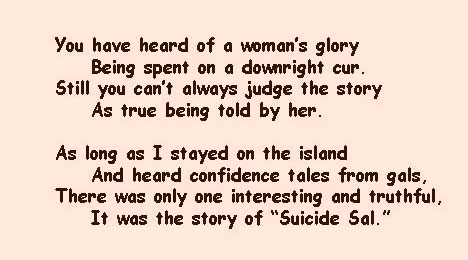 |
Her best-known poem was her last, entitled "The Trail's End," though it is better known as "The Story of Bonnie and Clyde." Before quoting the most memorable lines, I'm going to dwell a moment on this stanza:
|
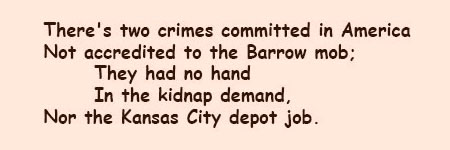 |
Kidnapping was big business in 1933 because some gangsters realized there was no future in bootlegging, and a few penny ante outlaws realized there was little money to be made from robbing banks.
While the kidnapping of Charles A. Lindbergh Jr. had been 1932's most horrific event, it remained unsolved in 1933. That fact may have misled certain people into believing kidnapping not only was a profitable crime, but relatively safe.
A few of 1933's many kidnappings involved children, but most of those abducted were adults, a high percentage being men who owned breweries.
To the public, kidnapping was a dastardly crime, which is probably why Bonnie Parker's defense of the Barrow gang included a reminder that, hey, at least we don't kidnap people.
Actually, they did ... though their several abductions weren't done for ransom.
On January 26, 1933, a Springfield, Missouri, motorcycle policeman, Tom Persell, became suspicious of Barrow and Parker, and W. D. Jones, a teenager who was with the gang for awhile. Persell pulled them over, but Beatty got the drop on him and ordered Persell to get into the car. Six hours later, after a long drive that wound up only a few miles from Springfield, they let Persell go.
On April 27, 1933, after stealing a car in Ruston, Louisiana, Barrow discovered he was being chased. The car's owner, H. Dillard Darby, was offered a ride by Miss Sophia Stone, and they went after the thief. When they caught up to Barrow, he ordered them, at gunpoint, to get into the stolen vehicle, and off they went on another long drive before the two strangers were put out of the car in Waldo, Arkansas.
On February 12, 1934, Clyde, Bonnie and outlaw Raymond Hamilton survived a couple of skirmishes with lawmen and abducted two men along the way, letting both go near Berryville, Arkansas.
On April 6, 1934, after fatally shooting Constable Cal Campbell near Commerce, Oklahoma, and wounding Police Chief Percy Boyd, Barrow ordered Boyd to get into the car, which was stuck in some mud. Barrow flagged down a truck to liberate his vehicle, telling the driver to warn other lawmen to back off or he'll kill Boyd. Several hours later Barrow released Boyd near Fort Scott, Kansas. During his time in the car, the police chief, who wasn't seriously hurt, observed that Bonnie Parker smoked cigarettes, not cigars. She even asked him to spread the word that she is not a cigar smoker, saying "nice girls don't smoke cigars."
There were other such incidents during the brief careers of Bonnie and Clyde. The links provided are all from an interesting website called Bonnie & Clyde's Hideout, by Frank. R. Ballinger.
As for "the Kansas City depot job," for defenseless violence, that crime — often called "The Kansas City Massacre" or "The Union Station Massacre" — may have been 1933's worst.
Someone should have reminded Ms. Parker that in three separate incidents that year, the Barrow mob killed four lawmen, the same number killed during the Kansas City shootout. During the year the Barrows wounded several more lawmen.
The law took its revenge on May 23, 1934, and the final stanza of Bonnie Parker's final poem was both prophetic and appropriate:
|
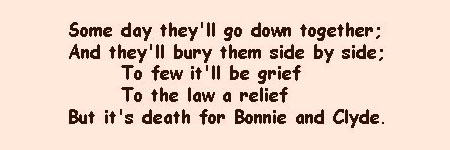
|
However, Mrs. Emma Parker would not let her daughter be buried next to Clyde Barrow. And there was no way of knowing that years later, because of Hollywood's disregard for history and a new generation's ignorance of or disrespect for the past, Bonnie Parker and Clyde Barrow would be re-born and given a glamorous makeover.
|
| |
* The most interesting person in this extended story of Bonnie and Clyde may well be Katie Jenkins — IF the young woman involved with Raymond Hamilton is the same Katie Jenkins who married Texas-born boxer Lew Jenkins who won the world lightweight title in 1940.
I exchanged a few emails with Frank Ballinger, who created the interesting website Bonnie & Clyde's Hideout. After we compared notes, we agreed that Katie Jenkins, girl friend of Raymond Hamilton, and Katie Jenkins, wife and manager of Lew Jenkins, were one and the same.
Also known as Katie Kemper, this attractive and free-spirited woman was born Katie Jenkins, and didn't have to change her last name when she married Lew Jenkins. By then she was known as a midget auto racer and fledgling flier, having chalked up the modest total of 20 solo hours in the air.
As the wife of Lew Jenkins, she attracted attention by stepping into the ring during his fights and barking instructions at him.
After their divorce, she managed other fighters, including Carmine Fatta, but so far I've found no stories about her life after boxing.
Anyway, Ballinger beat me to the punch and created a Katie Jenkins page on his website.
|
| |
| HOME • CONTACT |
| |
|




